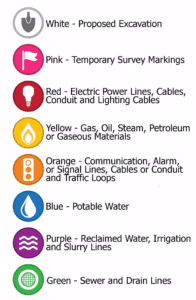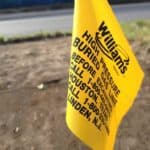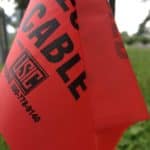If you found this article, chances are that you have just discovered a new set of colored little flags in your yard, but your not sure why. Although we can’t specifically answer your question here, we can help shed some light on a few of the possibilities about what is happening. For the quickest answers, call you local Call 811 center by dialing 811 from any land line or cell phone.
Why are there utility flags in my yard?
First, we can help answer they “Why” part of the equation. There is typically only a few reasons these types of little colored flags will appear in your yard or lawn. The primary reason is because there is a planned excavation in the vicinity of your property. Before you blow your stack, relax a little bit. This does not mean that someone will be parking a huge excavator in front of your home and tearing up your entire lawn. The excavation could be for anything, maybe the fire hydrant across the street is being repaired, or your next door neighbors are installing a new mailbox or clothes line.
Just because the flags are in your lawn does not mean your lawn will be effected. Many times, the individuals or companies who call in the “Call 811 Ticket” request to dig does not have all of the information needed to pin-point the locate technicians to the exact spot of the work. Instead, they will call in several properties for one small excavation just to make sure that the locators have marked the proposed work area. For instance, it is not that uncommon for an electric company to call in a 150′ radius of a utility pole that is going to be replaced. Typically they will replace the pole in the exact same location of the existing pole, or within a few feet, but regardless they always seem to call in way more than they need.
The other reason flags have appeared in your yard is because someone is planning to do work. Engineers will request to have utilities marked out so that they can design new utility systems around the old ones. This practice is often refereed to as Subsurface Utility Engineering. If you happen to notice that these flags have shown up in your entire neighborhood, this is likely the case. There won’t be any excavating in the near future, for a while anyways.
What do all of the colors stand for?
 The color of the flags are typically going to follow The American Public Works Association (APWA) Uniform Color Code. Note that if you see any white paint or flags, this is typically marking the route of the proposed excavation. You may also see a marking in the street or near a pole or structure with an arrow that says “Call 811,” “Miss Utility,” “One Call,” “Dig Safe,” “UFPO,” etc. Here is the official color code chart that is used to depict the location of underground utilities. The colors are as follows are noted in this handy chart.
The color of the flags are typically going to follow The American Public Works Association (APWA) Uniform Color Code. Note that if you see any white paint or flags, this is typically marking the route of the proposed excavation. You may also see a marking in the street or near a pole or structure with an arrow that says “Call 811,” “Miss Utility,” “One Call,” “Dig Safe,” “UFPO,” etc. Here is the official color code chart that is used to depict the location of underground utilities. The colors are as follows are noted in this handy chart.
Can I move the utility flags in my yard?
Unfortunately no. In most states, it is illegal to tamper with any underground utility markings that were placed in accordance with your states Call 811 dig laws.
According to the Pennsylvania Underground Utility Line Protection Act (Act 287):
“SECTION 10. No person shall intentionally remove or tamper with a marking provided for under this act.”
Moving or removing flags and paint markings will ultimately make you liable for any damage that occurs to that utility, and trust us those can be expensive. For most homeowners, your insurance policies will likely not cover the damages that arise from what the Utility Commission will classify as negligence.
If you need or want to remove the flags, our suggestion is that you call your local state-run dig center by simply dialing 811 (just like 911 but replace the 9 with an 8!). Speak with the 811 operator and ask if they can provide any information about what is happening at your address. They should be able to provide the contact name and number for the individual who called in the dig request. You can then speak with this person to see if they have completed the work or if the flags are even needed in your yard.
If you are not able to get any information from your State’s Call 811 Center, you can try to call the utility company that placed the flag. If you found blue flags, you can try your water company. For red flags, try to call your Electric Company. For orange flags, you could try to call your telephone or Cable TV company. For yellow flags, try to call your natural gas provider, and for green flags try to call your local sanitary sewer authority or DPW.
Inspect the Flags

Carefully inspect the flags as some companies may include some form of contact information printed on each flag. At Utility Locator®, our company uses our own flag (see example) to delineate the lines we have marked out. If the utility flags on your lawn do not have our logo imprinted on them, then we did not mark that utility and will not be able to provide any information regarding the flags or proposed work.
Examples of Utility Flags
Here are a few examples of the little colored utility flags that mark the location of underground utilities:















